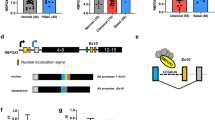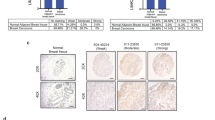Abstract
The splicing-factor oncoprotein SRSF1 (also known as SF2/ASF or ASF/SF2) is upregulated in breast cancers. We investigated the ability of SRSF1 to transform human and mouse mammary epithelial cells in vivo and in vitro. SRSF1-overexpressing COMMA-1D cells formed tumors, following orthotopic transplantation to reconstitute the mammary gland. In three-dimensional (3D) culture, SRSF1-overexpressing MCF-10A cells formed larger acini than control cells, reflecting increased proliferation and delayed apoptosis during acinar morphogenesis. These effects required the first RNA-recognition motif and nuclear functions of SRSF1. SRSF1 overexpression promoted alternative splicing of BIM (also known as BCL2L11) and BIN1 to produce isoforms that lack pro-apoptotic functions and contribute to the phenotype. Finally, SRSF1 cooperated specifically with MYC to transform mammary epithelial cells, in part by potentiating eIF4E activation, and these cooperating oncogenes are significantly coexpressed in human breast tumors. Thus, SRSF1 can promote breast cancer, and SRSF1 itself or its downstream effectors may be valuable targets for the development of therapeutics.
This is a preview of subscription content, access via your institution
Access options
Subscribe to this journal
Receive 12 print issues and online access
$189.00 per year
only $15.75 per issue
Buy this article
- Purchase on Springer Link
- Instant access to full article PDF
Prices may be subject to local taxes which are calculated during checkout







Similar content being viewed by others
References
Wang, E.T. et al. Alternative isoform regulation in human tissue transcriptomes. Nature 456, 470–476 (2008).
Cartegni, L., Chew, S.L. & Krainer, A.R. Listening to silence and understanding nonsense: exonic mutations that affect splicing. Nat. Rev. Genet. 3, 285–298 (2002).
Mayeda, A. & Krainer, A.R. Regulation of alternative pre-mRNA splicing by hnRNP A1 and splicing factor SF2. Cell 68, 365–375 (1992).
Cáceres, J.F., Stamm, S., Helfman, D.M. & Krainer, A.R. Regulation of alternative splicing in vivo by overexpression of antagonistic splicing factors. Science 265, 1706–1709 (1994).
Srebrow, A. & Kornblihtt, A.R. The connection between splicing and cancer. J. Cell Sci. 119, 2635–2641 (2006).
Ghigna, C., Moroni, M., Porta, C., Riva, S. & Biamonti, G. Altered expression of heterogenous nuclear ribonucleoproteins and SR factors in human colon adenocarcinomas. Cancer Res. 58, 5818–5824 (1998).
Fischer, D.C. et al. Expression of splicing factors in human ovarian cancer. Oncol. Rep. 11, 1085–1090 (2004).
He, X., Ee, P.L., Coon, J.S. & Beck, W.T. Alternative splicing of the multidrug resistance protein 1/ATP binding cassette transporter subfamily gene in ovarian cancer creates functional splice variants and is associated with increased expression of the splicing factors PTB and SRp20. Clin. Cancer Res. 10, 4652–4660 (2004).
Stickeler, E., Kittrell, F., Medina, D. & Berget, S.M. Stage-specific changes in SR splicing factors and alternative splicing in mammary tumorigenesis. Oncogene 18, 3574–3582 (1999).
Zhang, Z. & Krainer, A.R. Involvement of SR proteins in mRNA surveillance. Mol. Cell 16, 597–607 (2004).
Huang, Y., Gattoni, R., Stévenin, J. & Steitz, J.A. SR splicing factors serve as adapter proteins for TAP-dependent mRNA export. Mol. Cell 11, 837–843 (2003).
Michlewski, G., Sanford, J.R. & Cáceres, J.F. The splicing factor SF2/ASF regulates translation initiation by enhancing phosphorylation of 4E–BP1. Mol. Cell 30, 179–189 (2008).
Sanford, J.R., Gray, N.K., Beckmann, K. & Cáceres, J.F. A novel role for shuttling SR proteins in mRNA translation. Genes Dev. 18, 755–768 (2004).
Sun, S., Zhang, Z., Sinha, R., Karni, R. & Krainer, A.R. SF2/ASF autoregulation involves multiple layers of post-transcriptional and translational control. Nat. Struct. Mol. Biol. 17, 306–312 (2010).
Karni, R. et al. The gene encoding the splicing factor SF2/ASF is a proto-oncogene. Nat. Struct. Mol. Biol. 14, 185–193 (2007).
Pind, M.T. & Watson, P.H. SR protein expression and CD44 splicing pattern in human breast tumours. Breast Cancer Res. Treat. 79, 75–82 (2003).
Watermann, D.O. et al. Splicing factor Tra2-beta1 is specifically induced in breast cancer and regulates alternative splicing of the CD44 gene. Cancer Res. 66, 4774–4780 (2006).
Sinclair, C.S., Rowley, M., Naderi, A. & Couch, F.J. The 17q23 amplicon and breast cancer. Breast Cancer Res. Treat. 78, 313–322 (2003).
Deugnier, M.A. et al. Isolation of mouse mammary epithelial progenitor cells with basal characteristics from the Comma-Dbeta cell line. Dev. Biol. 293, 414–425 (2006).
Zhan, L. et al. Deregulation of scribble promotes mammary tumorigenesis and reveals a role for cell polarity in carcinoma. Cell 135, 865–878 (2008).
Debnath, J. & Brugge, J.S. Modelling glandular epithelial cancers in three-dimensional cultures. Nat. Rev. Cancer 5, 675–688 (2005).
Cáceres, J.F., Misteli, T., Screaton, G.R., Spector, D.L. & Krainer, A.R. Role of the modular domains of SR proteins in subnuclear localization and alternative splicing specificity. J. Cell Biol. 138, 225–238 (1997).
Wu, H. et al. A splicing-independent function of SF2/ASF in microRNA processing. Mol. Cell 38, 67–77 (2010).
Muthuswamy, S.K., Li, D., Lelievre, S., Bissell, M.J. & Brugge, J.S. ErbB2, but not ErbB1, reinitiates proliferation and induces luminal repopulation in epithelial acini. Nat. Cell Biol. 3, 785–792 (2001).
Debnath, J. et al. The role of apoptosis in creating and maintaining luminal space within normal and oncogene-expressing mammary acini. Cell 111, 29–40 (2002).
Karni, R., Hippo, Y., Lowe, S.W. & Krainer, A.R. The splicing-factor oncoprotein SF2/ASF activates mTORC1. Proc. Natl. Acad. Sci. USA 105, 15323–15327 (2008).
Ghigna, C. et al. Cell motility is controlled by SF2/ASF through alternative splicing of the Ron protooncogene. Mol. Cell 20, 881–890 (2005).
Ge, K. et al. Mechanism for elimination of a tumor suppressor: aberrant splicing of a brain-specific exon causes loss of function of Bin1 in melanoma. Proc. Natl. Acad. Sci. USA 96, 9689–9694 (1999).
Scheper, G.C. et al. The N and C termini of the splice variants of the human mitogen-activated protein kinase-interacting kinase Mnk2 determine activity and localization. Mol. Cell. Biol. 23, 5692–5705 (2003).
Reginato, M.J. et al. Bim regulation of lumen formation in cultured mammary epithelial acini is targeted by oncogenes. Mol. Cell. Biol. 25, 4591–4601 (2005).
O'Connor, L. et al. Bim: a novel member of the Bcl-2 family that promotes apoptosis. EMBO J. 17, 384–395 (1998).
Mami, U., Miyashita, T., Shikama, Y., Tadokoro, K. & Yamada, M. Molecular cloning and characterization of six novel isoforms of human Bim, a member of the proapoptotic Bcl-2 family. FEBS Lett. 509, 135–141 (2001).
Cáceres, J.F. & Krainer, A.R. Functional analysis of pre-mRNA splicing factor SF2/ASF structural domains. EMBO J. 12, 4715–4726 (1993).
Cazalla, D. et al. Nuclear export and retention signals in the RS domain of SR proteins. Mol. Cell. Biol. 22, 6871–6882 (2002).
Pedraza-Fariña, L.G. Mechanisms of oncogenic cooperation in cancer initiation and metastasis. Yale J. Biol. Med. 79, 95–103 (2006).
Hynes, N.E. & Stoelzle, T. Key signalling nodes in mammary gland development and cancer: Myc. Breast Cancer Res. 11, 210 (2009).
Lee, E.Y. & Muller, W.J. Oncogenes and tumor suppressor genes. Cold Spring Harb. Perspect. Biol. 2, a003236 (2010).
Lin, C.J., Cencic, R., Mills, J.R., Robert, F. & Pelletier, J. c-Myc and eIF4F are components of a feedforward loop that links transcription and translation. Cancer Res. 68, 5326–5334 (2008).
Ruggero, D. et al. The translation factor eIF-4E promotes tumor formation and cooperates with c-Myc in lymphomagenesis. Nat. Med. 10, 484–486 (2004).
Miao, J. et al. Identification and characterization of BH3 domain protein Bim and its isoforms in human hepatocellular carcinomas. Apoptosis 12, 1691–1701 (2007).
Schwerk, C. & Schulze-Osthoff, K. Regulation of apoptosis by alternative pre-mRNA splicing. Mol. Cell 19, 1–13 (2005).
Moore, M.J., Wang, Q., Kennedy, C.J. & Silver, P.A. An alternative splicing network links cell-cycle control to apoptosis. Cell 142, 625–636 (2010).
Li, X., Wang, J. & Manley, J.L. Loss of splicing factor ASF/SF2 induces G2 cell cycle arrest and apoptosis, but inhibits internucleosomal DNA fragmentation. Genes Dev. 19, 2705–2714 (2005).
Inoki, K., Corradetti, M.N. & Guan, K.L. Dysregulation of the TSC-mTOR pathway in human disease. Nat. Genet. 37, 19–24 (2005).
Lazaris-Karatzas, A., Montine, K.S. & Sonenberg, N. Malignant transformation by a eukaryotic initiation factor subunit that binds to mRNA 5′ cap. Nature 345, 544–547 (1990).
Topisirovic, I., Ruiz-Gutierrez, M. & Borden, K.L. Phosphorylation of the eukaryotic translation initiation factor eIF4E contributes to its transformation and mRNA transport activities. Cancer Res. 64, 8639–8642 (2004).
Dowling, R.J. et al. mTORC1-mediated cell proliferation, but not cell growth, controlled by the 4E-BPs. Science 328, 1172–1176 (2010).
Ngo, J.C. et al. A sliding docking interaction is essential for sequential and processive phosphorylation of an SR protein by SRPK1. Mol. Cell 29, 563–576 (2008).
Tintaru, A.M. et al. Structural and functional analysis of RNA and TAP binding to SF2/ASF. EMBO Rep. 8, 756–762 (2007).
Zuo, P. & Manley, J.L. Functional domains of the human splicing factor ASF/SF2. EMBO J. 12, 4727–4737 (1993).
Cáceres, J.F., Screaton, G.R. & Krainer, A.R. A specific subset of SR proteins shuttles continuously between the nucleus and the cytoplasm. Genes Dev. 12, 55–66 (1998).
Shaw, S.D., Chakrabarti, S., Ghosh, G. & Krainer, A.R. Deletion of the N-terminus of SF2/ASF permits RS-domain-independent pre-mRNA splicing. PLoS ONE 2, e854 (2007).
Yu, Q., Geng, Y. & Sicinski, P. Specific protection against breast cancers by cyclin D1 ablation. Nature 411, 1017–1021 (2001).
Li, S. et al. Translation factor eIF4E rescues cells from Myc-dependent apoptosis by inhibiting cytochrome c release. J. Biol. Chem. 278, 3015–3022 (2003).
Mao, D.Y. et al. Analysis of Myc bound loci identified by CpG island arrays shows that Max is essential for Myc-dependent repression. Curr. Biol. 13, 882–886 (2003).
Das, S., Anczuków, O., Akerman, M. & Krainer, A.R. SRSF1 is a critical transcriptional target of MYC. Cell Rep. (in the press).
Elliott, K. et al. Bin1 functionally interacts with Myc and inhibits cell proliferation through multiple mechanisms. Oncogene 18, 3564–3573 (1999).
Sakamuro, D., Elliott, K.J., Wechsler-Reya, R. & Prendergast, G.C. BIN1 is a novel MYC-interacting protein with features of a tumour suppressor. Nat. Genet. 14, 69–77 (1996).
Debnath, J., Muthuswamy, S.K. & Brugge, J.S. Morphogenesis and oncogenesis of MCF-10A mammary epithelial acini grown in three-dimensional basement membrane cultures. Methods 30, 256–268 (2003).
Spancake, K.M. et al. E7-transduced human breast epithelial cells show partial differentiation in three-dimensional culture. Cancer Res. 59, 6042–6045 (1999).
Acknowledgements
We thank M. Egeblad, N. Tonks, V. Aranda and J. Novatt for helpful comments on the manuscript. We thank J. Erby Wilkinson for collaboration and helpful advice with histopathology, and we thank P. Moody for assistance with flow cytometry. This work was supported by grants from the National Cancer Institute (grant CA13106 to A.R.K. and CA098830 to S.K.M.), postdoctoral fellowships from the S.B. Komen Foundation for the Cure (grant KG091029 to O.A.) and from the Fondation pour la Recherche Médicale (grant SPE20070709581 to O.A.), an award grant from the Philippe Foundation to O.A. and an Era of Hope Scholar award from the Department of Defense Breast Cancer Research Program (grant BC075024 to S.K.M.).
Author information
Authors and Affiliations
Contributions
O.A. conducted the experiments. S.D. contributed to the apoptosis assays. M.A. conducted the microarray and statistical analyses. L.Z. contributed to the transplantation experiments. A.Z.R., R.K. and S.K.M. shared protocols and reagents. O.A. and A.R.K. designed the study, analyzed the data and wrote the paper. All authors discussed the results and commented on the manuscript.
Corresponding author
Ethics declarations
Competing interests
The authors declare no competing financial interests.
Supplementary information
Supplementary Text and Figures
Supplementary Figures 1–7, Supplementary Table 1 and Supplementary Methods (PDF 4123 kb)
Rights and permissions
About this article
Cite this article
Anczuków, O., Rosenberg, A., Akerman, M. et al. The splicing factor SRSF1 regulates apoptosis and proliferation to promote mammary epithelial cell transformation. Nat Struct Mol Biol 19, 220–228 (2012). https://doi.org/10.1038/nsmb.2207
Received:
Accepted:
Published:
Issue Date:
DOI: https://doi.org/10.1038/nsmb.2207
This article is cited by
-
CircHAT1 regulates the proliferation and phenotype switch of vascular smooth muscle cells in lower extremity arteriosclerosis obliterans through targeting SFRS1
Molecular and Cellular Biochemistry (2024)
-
Role of epithelial splicing regulatory protein 1 in cancer progression
Cancer Cell International (2023)
-
Splicing factor-mediated regulation patterns reveals biological characteristics and aid in predicting prognosis in acute myeloid leukemia
Journal of Translational Medicine (2023)
-
HLTF promotes hepatocellular carcinoma progression by enhancing SRSF1 stability and activating ERK/MAPK pathway
Oncogenesis (2023)
-
Dysregulation of alternative splicing contributes to multiple myeloma pathogenesis
British Journal of Cancer (2023)



